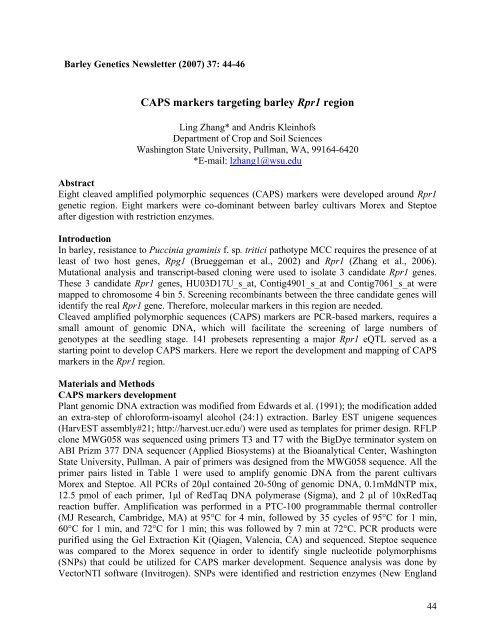BARLEY GENETICS NEWSLETTER - GrainGenes - US Department ...
BARLEY GENETICS NEWSLETTER - GrainGenes - US Department ...
BARLEY GENETICS NEWSLETTER - GrainGenes - US Department ...
You also want an ePaper? Increase the reach of your titles
YUMPU automatically turns print PDFs into web optimized ePapers that Google loves.
Barley Genetics Newsletter (2007) 37: 44-46<br />
CAPS markers targeting barley Rpr1 region<br />
Ling Zhang* and Andris Kleinhofs<br />
<strong>Department</strong> of Crop and Soil Sciences<br />
Washington State University, Pullman, WA, 99164-6420<br />
*E-mail: lzhang1@wsu.edu<br />
Abstract<br />
Eight cleaved amplified polymorphic sequences (CAPS) markers were developed around Rpr1<br />
genetic region. Eight markers were co-dominant between barley cultivars Morex and Steptoe<br />
after digestion with restriction enzymes.<br />
Introduction<br />
In barley, resistance to Puccinia graminis f. sp. tritici pathotype MCC requires the presence of at<br />
least of two host genes, Rpg1 (Brueggeman et al., 2002) and Rpr1 (Zhang et al., 2006).<br />
Mutational analysis and transcript-based cloning were used to isolate 3 candidate Rpr1 genes.<br />
These 3 candidate Rpr1 genes, HU03D17U_s_at, Contig4901_s_at and Contig7061_s_at were<br />
mapped to chromosome 4 bin 5. Screening recombinants between the three candidate genes will<br />
identify the real Rpr1 gene. Therefore, molecular markers in this region are needed.<br />
Cleaved amplified polymorphic sequences (CAPS) markers are PCR-based markers, requires a<br />
small amount of genomic DNA, which will facilitate the screening of large numbers of<br />
genotypes at the seedling stage. 141 probesets representing a major Rpr1 eQTL served as a<br />
starting point to develop CAPS markers. Here we report the development and mapping of CAPS<br />
markers in the Rpr1 region.<br />
Materials and Methods<br />
CAPS markers development<br />
Plant genomic DNA extraction was modified from Edwards et al. (1991); the modification added<br />
an extra-step of chloroform-isoamyl alcohol (24:1) extraction. Barley EST unigene sequences<br />
(HarvEST assembly#21; http://harvest.ucr.edu/) were used as templates for primer design. RFLP<br />
clone MWG058 was sequenced using primers T3 and T7 with the BigDye terminator system on<br />
ABI Prizm 377 DNA sequencer (Applied Biosystems) at the Bioanalytical Center, Washington<br />
State University, Pullman. A pair of primers was designed from the MWG058 sequence. All the<br />
primer pairs listed in Table 1 were used to amplify genomic DNA from the parent cultivars<br />
Morex and Steptoe. All PCRs of 20μl contained 20-50ng of genomic DNA, 0.1mMdNTP mix,<br />
12.5 pmol of each primer, 1μl of RedTaq DNA polymerase (Sigma), and 2 μl of 10xRedTaq<br />
reaction buffer. Amplification was performed in a PTC-100 programmable thermal controller<br />
(MJ Research, Cambridge, MA) at 95°C for 4 min, followed by 35 cycles of 95°C for 1 min,<br />
60°C for 1 min, and 72°C for 1 min; this was followed by 7 min at 72°C. PCR products were<br />
purified using the Gel Extraction Kit (Qiagen, Valencia, CA) and sequenced. Steptoe sequence<br />
was compared to the Morex sequence in order to identify single nucleotide polymorphisms<br />
(SNPs) that could be utilized for CAPS marker development. Sequence analysis was done by<br />
VectorNTI software (Invitrogen). SNPs were identified and restriction enzymes (New England<br />
44




